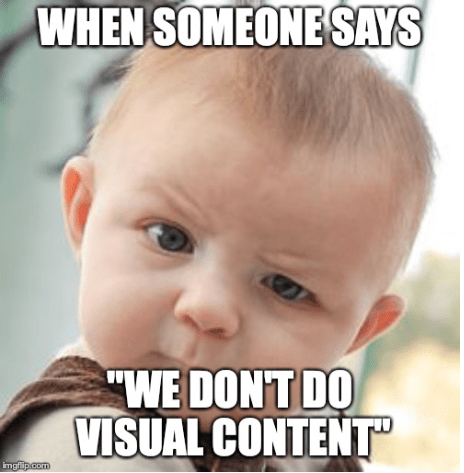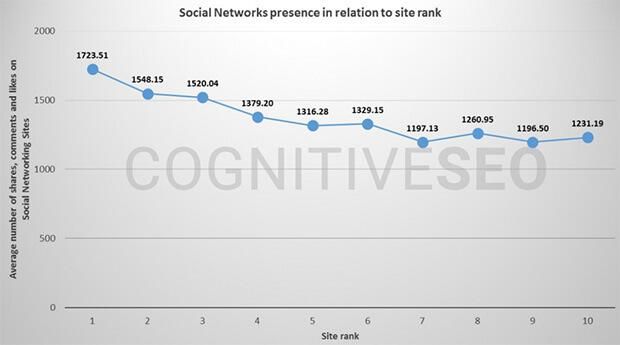There used to be a time when getting search rankings was about stuffing a bunch of keywords into content and linking to low-quality sites. SEO has come a long way since then, thanks to the rapid evolution in search engine algorithms and the wide range of SEO analysis tools available online. If a piece of content is relevant to the audience and manages to engage them, it gets a thumbs up from Google. But wait, it’s not all that simple. With every business producing content, there is no limit to how far you can go to please the audience. There is content everywhere and it gets harder to earn visibility. There are more than 1.5 billion websites on the internet right now. Visual content adds value to the audience and makes it unique.

Let’s discuss why visual content formats such as videos, infographics, GIFs, and memes are the new weapons in an SEO arsenal:
The audience today, can find any information they wish to, online. Millennials and the Gen Z’ers are habitual of using multiple devices at one time. According to MarketingSherpa, as much as 50 percent of website visitors determine whether to continue navigating a web page or abandon it within 8 seconds.
Visual content makes it easy for site visitors to learn more in less time. Images are more memorable.
When people hear information, they’re likely to remember only 10% of that information three days later. However, if a relevant image is paired with that same information, people retained 65% of the information three days later.
Sharp data visualizations, infographics and charts save time that readers would otherwise spend reading an entire blog post. Visual content is attractive, enhances the visitor experience, and just gives back your audience precious time.
Studies show that a higher time spent on a website correlates with higher search rankings. This is especially true after Google implemented the Rankbrain algorithm in 2015. Having a video on your website’s landing page gets the user to stick around and watch the video, for instance. The same is true of infographics and images within blog posts and product pages. Visuals add a feel-good factor to a business’s digital presence.
Quality back-linking is one of the top search ranking factors. Backlinks add to a site’s authority and display its domain expertise. Linking to top sites remains a big challenge for SEO professionals. Visual content can help generate hundreds of backlinks in just a few months! Create an infographic on a trending topic – and it might turn into an SEO goldmine for your business.
But don’t leave it up to chance, the best way to generate links is to plan out a content promotion strategy that includes outreach to influencers, major publications, and your own network to link back to your piece. As your content gains popularity, more websites will be likely to link to it.
The following graphic from Cognitive SEO shows a positive correlation between a site’s social presence and its search rankings.

Social activity adds to a website’s credibility and click-through rate. It fetches more content visibility improving the chances of getting more link-backs on it. With evolving social algorithms, it is visual content that shows up in newsfeeds as opposed to text-based content.
Facebook posts with images see 2.3X more engagement than those without images.
More than 500 million Facebook users are watching videos on Facebook every day.
Visual content is more likely to improve audience interaction on social channels adding to site popularity and search rankings.
While creating visual content is the way-to-go SEO strategy, optimizing it for search engines comes is an essential prerequisite. Let’s understand what you can do to optimize different types of visuals:
Don’t forget to add meta titles, descriptions, alt tags, and description tags to visual content assets. These tags should include the targeted key phrase for Google to show these visuals up in image search. One necessary tactic is to compress images before putting them up on your site. Choose images that look good and go with your brand voice – the strategy helps to improve website experience and adds SEO value.
The first step in optimizing an infographic for SEO is to find the right topic for it. Do your keyword research to ideate a headline that draws your audience. You can survey ideal customers to know about their pain points, for instance. Make use of platforms like Feedly, Buzzsumo, and Quora to make a list of trending topics in your niche. Don’t forget to optimize the infographic content with keywords – treat it like the usual blog post. Remember, you need to consider an infographic like any other site image and include keyword optimized meta tags for better searchability. Last, but not the least, make sure your infographic is optimized for mobile devices. Here are some bonus tips:
First off, you should focus on creating high-quality videos. Audiences enjoy video content that looks and sounds professional. Publishing and optimizing video content on the right hosting platform ensures it gets optimum search visibility. Use the right tags and a keyword optimized title and description at this stage. A definitive way to drive organic traffic is to integrate videos to your blog content. Video and text-based content complement each other and together, add SEO value. Social Media channels today, are a hub of video content. They allow you to benefit from social search as well as supplement organic search results. Sharing native videos on platforms like Facebook, Instagram, LinkedIn, and Twitter is a necessary SEO tactic. Live videos are in vogue too. Don’t forget to use the right keyword hashtags while publishing video content on these channels.
“Successful SEO is not about tricking Google. It’s about PARTNERING with Google to provide the best search results for Google’s users.” – Phil Frost
Online users are loaded with options. If they don’t like a piece of content, they have many others hungry for their attention. Visuals make an impact while providing quick answers to searcher queries. The format enlivens branded content and entertains the audience, taking their experience one level up. But marketers should not make the mistake of taking visual content as the end all be all SEO hack. The ideal way is to tell compelling stories through visual content and optimize each piece for search.
Author Bio:
Abhishek Talreja, founder of Prolific Content Marketing, is a passionate writer and an experienced content marketing expert. He has been published on top marketing blogs and works with companies all around the globe, helping them to earn online visibility and reputation. Connect with him on LinkedIn.